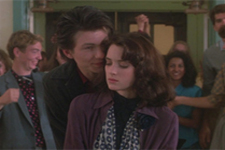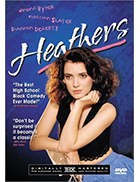Heathers
|  In the 12 years since its initial (and brief) theatrical release at the end of the John Hughes cycle of teen comedies and dramas in the late 1980s, Heathers has not aged a bit, and its sharp satirical edges show no sign of wear or softness. If anything, the passage of time has only emphasized just how prescient Heathers was in 1989. The points it makes about the violence-prone absurdity of American adolescence are perhaps even more incisive today than they were then. Heathers turned the '80s teen comedy genre on its head, replacing adolescent angst and prom dreams with barbed black comedy and wicked, subversive satire. The story takes place deep in the heartland, in the fictional suburban world of Westerburg, Ohio. The fundamental social hierarchy of the American high school is firmly in place at Westerburg High, with the most popular clique in school, composed of three gorgeous queen-bitches all named Heather (Shannen Doherty, Lisanne Falk, and Kim Walker), ruling their high-school universe with ruthless tyranny. Embodied best in the lead Heather played by Kim Walker, the "popular" clique is more adequately described as "feared." The movie makes it clear that popularity has little to do with being liked and everything to do with intimidation and envy. The youngest member of the clique, Veronica Sawyer (Winona Ryder), goes along with the three Heathers because, like them, she is pretty and wealthy and generates adulation from others. But, we immediately get the sense that she does not revel in the teenage sadism that stokes her friends so much. Veronica is savvy and intelligent, but she has an inner weakness that allows her to submit to the Heathers even when she doesn't like what she's doing. Enter J.D. (Christian Slater), the new kid in school who smokes, rides a motorcycle, wears a long black leather jacket, and talks like Jack Nicholson. A self-styled outsider and rebel, J.D. is much like his iconic namesake, James Dean, but with a perverted, psychotic twist that ironically makes him that much more appealing. Veronica is instantly drawn to him, perhaps because he offers her something different. In a world in which everyone is immediately subsumed into some kind of generic category, J.D. willfully stands apart from the crowd; there is no one else in school like him. J.D. quickly lures Veronica under spell and into his diabolical plans to off the students who he finds despicable, most notably the titular Heathers. The first murder is something of a happy accident, if it can be called that, and J.D. and Veronica light on the idea of disguising the murder as a suicide. This leads to a series of ironic developments in which the much-loathed and feared Heathers are suddenly raised in death to undeserved martyr status. In a single stroke, the movie drags virtually every character into its exposé of facetiousness, as teachers wax poetic about how much they enjoyed having the dead students in school and the yearbook staff prepares a two-page spread complete with reproductions of the suicide notes. In working with J.D., Veronica essentially exchanges her submission to the emotionally sadistic Heathers for submission to the murderous J.D., and the movie gains a strong dramatic undercurrent in watching her emerge from both of these dominions, eventually coming into her own by the end of the movie. Although Veronica's name is nowhere in the title, Heathers is ultimately about how she finally learns to be her own person, even though her journey to that point racks up quite a body count. Heathers was a first-time project for just about everyone involved, including director Michael Lehmann and writer Daniel Waters (both of whom almost detonated their careers two years later with their involvement in the Bruce Willis-Joel Silver debacle Hudson Hawk in 1991). It was also made during the waning days of New World Pictures, the independent studio that funded and distributed the movie. This combined to create an experimental atmosphere that was absolutely essential for a movie like Heathers, an environment in which the filmmakers could feel free to push the envelope and raise a few eyebrows. The movie has all kinds of oddball details, like the fact that Veronica writes in her diary while wearing a monocle and the Heathers wile away their afternoons playing croquet, but what people really remember about the movie is how fearless it is in treading on potentially controversial territory. Truth be said, much of Heathers is in extremely bad taste, but it's so funny and so clever and so intent on its vision of teenage angst that the bad taste not only becomes utterly integral, it somehow transcends the barriers of appropriateness. It shares the same kind of anarchic spirit that made John Waters' early movies so gross and liberating at the same time. In Heathers, the filmmakers are essentially rejecting all of the nostalgia and emotional tripe that often accompanies excursions into the world of American adolescence and laying bare the ugly undercurrents that no one wants to admit are there. Kids killing other kids because they don't like them looks sick on paper, but Heathers deals with its controversial subject matter with such style and wit that the violence is taken to another plane; it's grotesque, but it's so absurdly grotesque that you can't take it seriously. The film is visually inventive, which goes a long way toward covering over the fact that the screenplay starts to fall apart toward the end. Cinematographer Francis Kenny alternates between bright, almost cartoonish images and dark, brooding moments that play off horror movies and psycho thrillers. It has a quick pace and a rhythm all its own, aided in great part by screenwriter Daniel Waters' fantastic twisting of the English language into his own personal brand of teenspeak that results in endlessly quotable lines. The movie cuts close to the bone now (with incidents like Columbine) as it did then (when teenage suicide was a major national trauma), and that's what makes it work so well. It pushes hot buttons and jabs at sensitive areas to make the point that so much in life—especially the lives of privileged American teens—is just plain silly. At the same time, though, it makes the point that killing people like the Heathers is an exercise in futility because someone else will always rise up to take their place. In its darkest moments, Heathers suggests that there will always be cruelty at the top and subjugation at the bottom. The plurality of the title can be seen as relating not only to the three Heathers in the movie, but to the fact that there are Heathers everywhere and there always will be.
Copyright © 2001 James Kendrick | |||||||||||||||||||||||||||||||||||||||||||||||
Overall Rating: 


 (3.5)
(3.5)


